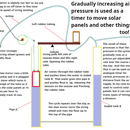Introduction: Save the Bees From Extinction! You CAN Do It.
In North America 4 THOUSAND types of bees are disappearing!
Some are extinct already.
This is a NEW method to make bee habitat.
Colony collapse disorder is hard to blame when most bees are solitary!
Thats right, most types of bees live alone.
One big reason that they are disappearing is habitat loss.
This instructable suggests ways to provide solitary bees with brood space and overnight shelter in an attempt to replace some of that lost habitat. So far it is working much better than I expected.
Step 1: Cob and Rods and Stems and Things
I have worked on since spring is to make blocks of cob (sand clay water and straw mixed to a gooey constituency and let dry. What I did was to get various different sizes of metal rod and push them into a block of wet cob and then let it dry for a couple of days. Before it is completely dry, I take out the rods and this left holes for the bees.
I show a couple of the blocks here.
It worked and there are at least 4 types of bees living in the block.
I recently discovered that solitary bees burrow inside old raspberry canes!
So one really easy thing you can do to help the bees is to bundle up old raspberry canes and leave the bundle in a dry south facing location. I am sure the bees will find them, burrow into some and leave some bee babies to hatch out next spring.
Step 2: Cob and Bars and Stems
I layer the bars and stems in the cob and try to pack as many sizes and types of stems as possible. So I use dill, weed stems, cicily stems, grape vines, and brassica stems that have gone to seed.
Anything hollow or with a pithy middle.
Step 3: Shelter, Brood and Success!
I attach some pictures of different types of bees that enter the holes in the cob and that enter the stems. I made one ugly cob and stem block last week and the bees are starting to use it now. There are about 5 types of bees using the cob blocks. The wasp mimic uses it for shelter at night, a bee about the size of the orchard masons uses it for brood. A green bee seems to use it for brood. A tiny black bee uses some small and medium holes and a large brown bee uses it too. Today, 3rd august, tiny bees were swarming a little near the cob and stem block and a large bee used one of the front holes.
Step 4: Links Other People Make Bee Habitat Too!
I just found a few really good links!! (August 2011). One is in German but it has TONS of pictures that really help explain what is going on. (It's kinds freaky because some of it is so similar to some of the stuff I did). It is on a much larger scale than anything I did and definitely worth importing to North America.
http://www.wildbienen.de/wbs-bsta.htm
And another is in English http://www.foxleas.com/bee_house.htm
http://resonatingbodies.wordpress.com/ seems to be artists and scientists coming together to make beautiful bee habitat.
http://www.flickr.com/groups/1407357@N20/ is pictures of home made bee and wasp houses.
Don't be afraid of solitary wasps, they rarely sting, "she who runs away, can lay an egg tomorrow" and all that. Its the sterile frustrated social wasps and bees that cannot lay eggs that do most of the stinging.
You can just bundle teasel stems, or raspberry canes or any hollow stem or reed and produce bee habitat. http://www.permies.com/permaculture-forums/520_0/critter-care/orachard-mason-bees Dave from Camas, Washington has been bundling teasel stems for several years and some of his pics are at the link above. And they work!
http://www.cirrusimage.com/hymenoptera.htm Bees wasps and ants of north America
It should be noted that wasps, even Yellow Jackets perform pollination. I have seen them work hard on dill. Those yellow jackets also spend a lot of time eating aphids and caterpillars on trees. So in the ecosystem, they are an important part of the puzzle.
Here is a nice link to the solitary bees of the UK http://www.moraybeekeepers.co.uk/solitary_bees.htm
A guy in Toronto has just identified 19 NEW species of bee. Which means 19 more species of bees to save! (I think the thing in their picture is a hoverfly, it is hard to see but bees have 4 wings and a long tongue). The link is here http://www.treehugger.com/files/2010/09/new-bee-species-discovered-during-downtown-toronto-commute.php
Step 5: One Year Later!
I had hoped to post pictures a week or 2 ago but the shutter broke on my camera and everything was over exposed. New camera now but no dates on the pictures. The cob bee blocks were very successful. Almost all the holes were filled, mostly in the spring of the second year. The bee vase seens less successful but I know that bees are still using it regularly. They have burrowed into the raspberry stems, vine stems and dill weed. Some have also used the cob holes.
Step 6: Save Me From the Rain!
It rained 6 or 7 mm today 22 August 2011 (first rain of the month) and the poor bees just hid and waited it out in any holes that did not have brood in them. Beats hypothermia, eh? Here are screenshots from the camera to show them waiting it out. It is just one picture but I zoomed parts of it to show the little bees. If you look carefully, you can see some holes with brood in them too. (capped off with mud) or you can just read the image notes.













